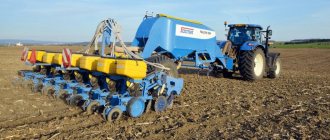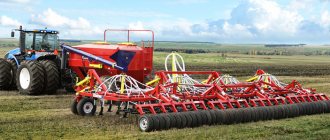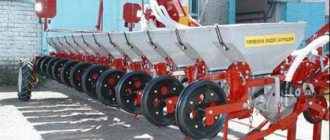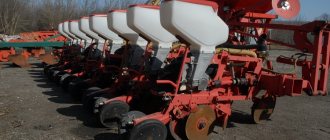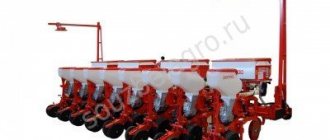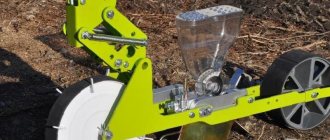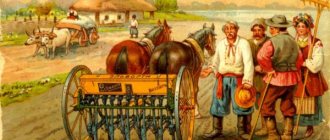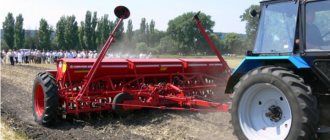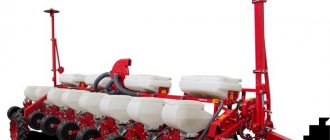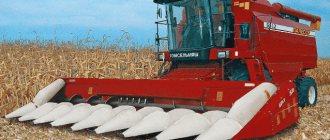The row sowing method is simple and convenient, but it has the disadvantage of empty row spacing. In order to prevent them from being occupied by weeds, and also not to waste fertile soil, these strips are sown with useful green manure herbs that improve the soil structure. For example, clover, rapeseed, mustard. The SZT-3.6 seeder will allow you to plant their seeds simultaneously with grain or legumes.
Seeder SZT-3.6
These machines are made by a well-known enterprise from Kirovograd - “Chervona Zirka” (“Red Star”). His specialization is technology for sowing and cultivating land. The plant is equipped with modern CNC lathes, Japanese and German laser cutting machines, as well as a unique Danish line for powder painting. The seeders produced from its production line are of high quality and reliable.
Model SZT-3.6 is a variation of the popular SZ-3.6 machine. It bears the name grain-grass, as it is equipped with a grass box with a reel sowing mechanism and separate point coulters. With its help, you can plant grain and the desired grass in one fell swoop on twenty-four rows, as well as apply fertilizer in granules. It is possible to connect three machines in a row, for which the SP-11G type coupling is used. In this case, you will need a tractor with a power of at least 150 horsepower, no less.
Another feature of this model is the presence of tedders and blowers, which help non-flowing seeds not to get stuck on the way to the sowing machine. If the mechanisms are not needed, they are turned off.
Purpose
Grain bins allow you to plant any legumes, as well as grains of wheat, oats, barley or other related crops into the soil. And smaller seeds are placed in the grass compartment. For example, mustard, rapeseed, clover, fescue, alfalfa, ryegrass, wheatgrass.
Moreover, it is not at all necessary to use all the functions of the unit at once. If you want to sow only grain or legumes with it, please do not fill the grass hopper. On the contrary, it is possible to sow clover, mustard or alfalfa separately.
Photo of the SZT-3.6 seeder
Advantages and disadvantages
Advantages:
- Simple and reliable design.
- The ability to combine sowing of different crops while simultaneously feeding the soil.
- Good movement speed.
- Combining three units with couplings allows you to triple the working width and thereby double the productivity.
- A tedder with a blower is a good help when sowing compacted seeds.
- The borated steel from which the openers are made makes them very durable.
- All metal parts are powder painted, which preserves their appearance for eight years (at least) and also protects them from destruction.
Flaws:
- If you constantly sow only grain, without grass, then the anchors will wear out without being used for business. The same can be said about disc coulters, using the seeder exclusively for sowing mustard or rapeseed.
- The double-disc type of openers is less efficient compared to the single-disc type.
NWT-5.4
The SZT-5.4 model is designed for sowing grain or legume crops in a row method simultaneously with grass seeds and mineral fertilizers. Sowing of crops is carried out from the main bunkers using disc-shaped coulters. From the green manure bunkers the following is introduced into the soil through the point coulters:
- loose seeds;
- medium-flowing seeds;
- loose seeds.
The grain-grass seeder has a mechanism for adjusting the rate of application of seed grass material. The neck of the sowing device of the grass bunker is equipped with a special supercharger. The grain containers are equipped with a grain and legume seed agitator, and the necks are equipped with a special supercharger. The point openers simultaneously serve as harrowers, and the unit itself is equipped with a hydraulic marker.
Specifications
| Working width of processing, m. | 5,4 |
| Operating speed, km/h. | 9-12 |
| Productivity, ha/h. | 4,9-6,5 |
| Row spacing, pcs. | 35/36 |
| Distance between rows, mm. | 75-150 |
| Application rate of agricultural crops, kg/ha | 5-400 |
| Grass seed application rate, kg/ha | 5-90 |
| Application rate of granular mineral fertilizers, kg/ha | 25-200 |
| Total volume of containers for grains or legumes, dm3. | 680 |
| Total volume of containers for green manure seeds, dm3. | 130 |
| Total volume of containers for mineral fertilizers, dm3. | 318 |
| Unit dimensions d/w/h, mm. | 2 950х6 750х2 750 |
| Equipment weight, t. | 2.81 |
| Aggregation, hp | up to 85 |
Owners of the SZT-5.4 model of grain-grass sowing equipment claim that it is a reliable and highly efficient unit. There are also increased productivity indicators at the same seeding rates and speed, in comparison with the SZT-3.6 model. Also popular is the SZT-5.8 seeder model, which is a modification of the SZT-5.6 and has only minor differences.
The SZT-5.4 seeder is highly efficient equipment, the price of which ranges from RUB 385,075. for a new unit and 307,000-340,000 for a used seeder. For farmers and agricultural enterprises, this equipment is an excellent assistant to increase the yield of sown crops. The video shows the operation of the SZT-5.4 seeder.
How do you like the article?
Device
The hydraulically powered metal frame of the machine is supported by two pneumatic wheels. At the top there are devices for control and adjustment. In addition, the frame contains containers for grain, fertilizers and grass seeds. There is a pressure mechanism above each of the bunkers, and there is also a tedder in the grain container.
The furrows for grain are made by coulters with two discs, and for grass seeds, they are made by point-type coulters, which cut into the ground less deeply and at an obtuse angle.
To fill the planted material, harrows (toothed or chain) are used. It is possible to replace them with rollers, useful for particularly sensitive varieties such as rapeseed.
The depth of the openers is changed by markers operating on hydraulics (as is the device for lifting the openers). The amount of granular fertilizer is adjusted by moving the corresponding valves - this changes the speed of rotation of the shaft. There are 6 gears for it, and 11 gears for the shaft of the grass sowing machine. The grain sowing device has 4 gears.
Diagram of the SZT-3.6 seeder
1 - frame; 2 - snitch; 3 — tool box; 4 - wheel; 5 — grain-fertilizer box; 6 — left drawer; 7 — footrest; 8 - vas deferens; 9 - opener; 10—vas deferens; 11 - opener.
PRECISION SEEDER
machine for sowing agricultural seeds crops with a given interval between them in a row (with dotted sowing) or a certain the number of seeds in the nest (for nest sowing). S.t.v. consists of a set of sections, each of which is a single-row seeder with a sowing device, coulter, suspension, and closing device. This design allows you to easily and quickly change the sowing spacing and arrange seeders of various types. rows, install on the frame of the S. t.v. cultivator or thinning sections. Basic working bodies of S. t.v. — a sowing apparatus that ensures individual selection of seeds in a hopper and their alternate feeding into the furrow, and coulters with harrows and rollers that ensure the placement of seeds at the bottom of the furrow, sprinkling them with soil and compacting it over the seeds.
Trailed row grain seeder: 1 — connecting bracket; 2 — hydraulic cylinder for raising the openers to the transport position; 3 - hopper with compartments for seeds and fertilizers; 4 — foot board; 5 - closing working bodies; 6 — sowing device; 7 - vas deferens; 8 - openers.
There are pneumatic sowing devices, which use vacuum or excess pressure to select seeds, and mechanical ones, which are based on a selecting cell (blind hole) based on the size of the seeds being sown. By design, sowing devices are divided into disk (with vertical, inclined and horizontal axes of rotation), drum and belt. Sowing seeds decomposition sizes (fractions) and crops are achieved by changing the sowing unit (disc, drum, tape). Openers are used keel-shaped, disc-shaped and runner-shaped with a wedge-shaped heel to ensure compaction of the bottom of the furrow. The uniformity of the depth of stroke of the coulters (2 - 12 cm) is achieved by using a limiter. rollers, flanges or skis and parallelogram or radially articulated suspensions.
Beet seeder SST-12B: 1 — marker: 2 — fertilizer sowing device; 3 - seed hopper; 4 — compacting roller; 5 - opener; 6 - frame.
Rollers with inflatable rubber tires are widely used. In the USSR, mounted S. t.v. are used. decomposition rows: 8-row with row spacing of 70 cm (SUPN-8) for sowing corn, 8 - 12-row with row spacing of 60 and 45 cm (SST-8A and SST-12B) for sowing sah. beets; 4 - 6-row with row spacing of 60 and 90 cm (SCHH-4A and SKHU-4) for sowing cotton. S.t.v. aggregated with row-crop tractors of classes 1.4 - 2.0 at speeds of 7 - 10 km/h. Foreign S. t.v. equipped with additional devices for applying dry or liquid pesticides and herbicides.
Share on the page
Specifications
Technical characteristics of the SZT-3.6 seeder:
| Characteristics | Indicators | Unit measurements |
| Device type | semi-trailer | |
| Traction power | at least 48 | kW |
| Capture | 3,6 | m |
| Number of rows (disc coulters) | 24 | PC. |
| Number of rows (point coulters) | 23 | PC. |
| Row spacing | 15/7,5 | cm |
| Performance | 32000-43000 | m2/h |
| Speed (operating) | from 9 to 12 | km/h |
| Seed sowing rate | 1,5-40 | g/m2 |
| Grass sowing rate | 0,5-9 | g/m2 |
| Planting depth (disc coulters) | 4-8 | cm |
| Planting depth (point coulters) | 2-8 | cm |
| Fertilizer application rate | 2,5-20 | g/m2 |
| Grain compartment volume | 0,453 | m3 |
| Fertilizer compartment volume | 0,212 | m3 |
| Grass compartment volume | 0,086 | m3 |
| Weight | 1,54 | T |
| Dimensions (length, height, width) | 4.3x1.65x3.7 | m |
The SZP seeder is the most popular seeder in the world
Champion seeder
It is difficult to find an agronomist who is not familiar with the “szshka” - the SZ seeder.
The first seeder of this model was created almost half a century ago. During this time, it became a classic grain trailed machine. In the USSR, they were produced in Kirovograd (modern name “Elvorti”) in Ukraine, in Russia “szshki” were made in the Penza region and “Sibselmash” in Novosibirsk, they were also manufactured in Kazakhstan. The model turned out to be so successful that many modifications were developed on the basis of the SZ-3.6 seeder: point-type for light soils, narrow-row for ordinary and rocky soils, grain-grass, single-disc, roller for peat soils, flax, etc.
The high level of unification of components and parts within the family of seeders greatly simplified the manufacture, operation and supply of spare parts, combined with simplicity in design, maintenance and general reliability in operation - all this contributed to the widespread use of seeding machines.
In the vast territory of the former Soviet Union, there is probably not a single farm where these seeders are used. At the turn of the century, more than one and a half million such seeders had already been produced. No seeder in the world has ever been produced in such huge quantities.
Universal grain seeder SZ-3.6 - adjustment and configuration
Seeder Grain 3.6 meters of grip (SZ-3.6) is a basic, long-proven and widely used model. Used for row sowing of grains (wheat, rye, barley, oats), legumes (peas, beans, chickpeas, soybeans, lentils, lupine) and other crops of similar size and seeding rate (buckwheat, sorghum and others).
A single seeder works with machines of a traction class of 0.9 or 1.4, if several at the same time, more powerful machines are used: 3 class with 3 in the coupling or 5 when connecting 5 SZ-3.6.
Modifications of the SZ-3.6A seeder
Based on the SZ-3.6A seeder, several modifications have been developed for sowing agricultural crops or their mixtures:
- SZ-3.6A-01 - for overseeding and fertilizing winter crops without preliminary tillage, equipped with single-disc coulters;
- SZ-3.6A-02 - for sowing flax, equipped with two-line point openers and harrows, can be used for sowing seeds of grain and leguminous crops with a seed placement depth of 10 to 30 mm;
- SZ-3.6A-03 - for sowing on light soils, equipped with point coulters for light soils and harrows;
Photo of grain seeder SZ 3.6
Seeder modifications
Grain seeder SZ-3.6 – basic model. The changes made to the design change the sowing conditions, price, and ease of use. Distributed SZ-3.6A. The differences of this model are as follows.
- It has a USK (unified control system) and is supplied only with it. If the seeds do not pour out into any coulter or when the level of grain (fertilizer) drops below a certain limit, it gives a signal to the tractor driver.
- Instead of a gear transmission in the SZ-3.6, the SZ-3.6A has two small-sized gearboxes; adjustment is more convenient, without removing the casing and replacing gears.
- Additionally, a sampler is installed on 3 right (in the direction of travel) coulters, which is used when adjusting the seeding rate.
- A device has been installed to block the seeding of seeds in coulters moving along the tramline. Instead of serrated hooks, there are tip hooks.
- Ears are attached to the foot board at the bottom, where you can attach the chains of seeding harrows.
- The drive shaft of the seed seeding coils has been changed from round to square.
If necessary, any SZ-3.6 seeder can be changed by installing, for example, coulters of a different design instead of the basic ones. It all depends on the crop being sown and working conditions (field preparation). Thus, in NWT-3.6, intended for subsurface sowing of grasses, there are fewer reels, since the seeds are smaller. And since they are also less flowable, an additional stirrer is installed in the box to help ensure an even flow of seeds.
